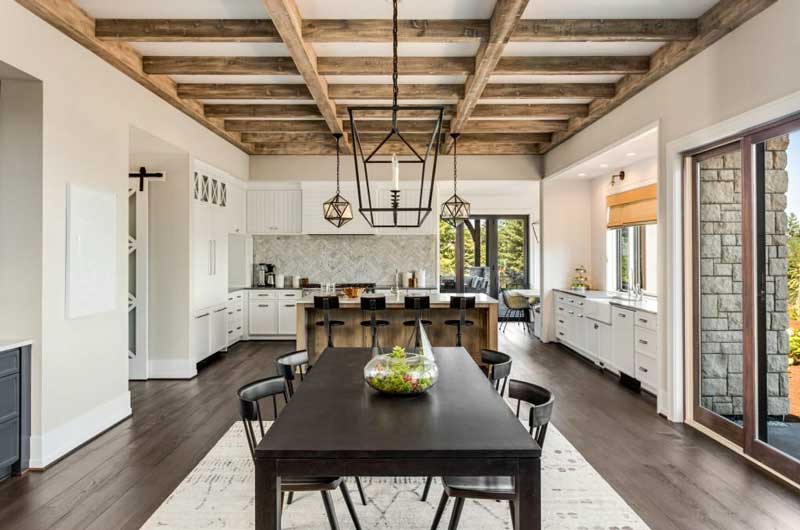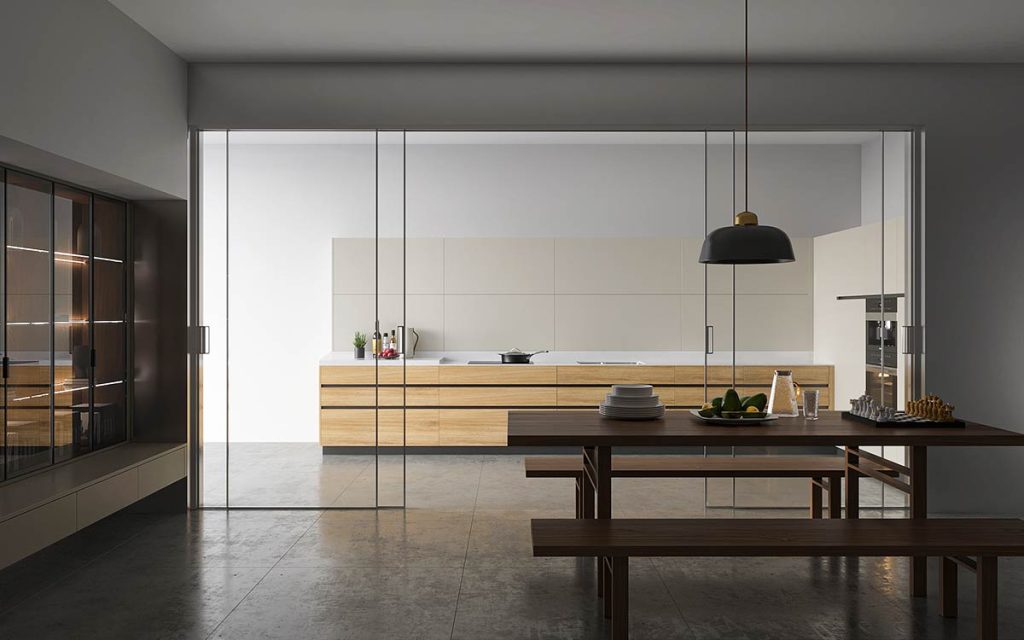Open floor plans for small kitchens offer space optimization and a seamless flow between cooking, dining, and living areas. However, they may lack privacy and create challenges in managing noise, odors, and visual clutter.
Additionally, limited storage can be an issue in small kitchens within open floor plans. An open floor plan can be a desirable feature in any home, especially for small kitchens. It allows for better utilization of space and promotes a smooth transition between different areas.
However, there are pros and cons to consider before opting for an open floor plan in a small kitchen. This article will explore the advantages and disadvantages of open floor plans for small kitchens, enabling you to make an informed decision.
Benefits Of Open Floor Plans For Small Kitchens

Open floor plans have become increasingly popular in modern homes, and for good reason. This design trend offers a range of benefits for small kitchens, making them appear larger and more inviting.
Increased Visual Space And Openness
One of the primary benefits of open floor plans for small kitchens is the increased visual space and openness they provide. By removing walls and barriers, the kitchen seamlessly flows into the surrounding areas, creating an expansive and airy atmosphere. The absence of visual obstructions allows the eyes to travel freely, making the entire space feel larger and more cohesive.
Improved Natural Lighting And Ventilation
Another advantage of open floor plans in small kitchens is the improved natural lighting and ventilation. With fewer walls, windows can be maximized, allowing ample sunlight to flood into the space. Natural light not only makes the kitchen appear brighter and more vibrant but also helps to create a positive and uplifting ambiance. Additionally, the open layout promotes better air circulation, ensuring a fresh and breathable environment.
Enhanced Social Interaction And Connectivity
Perhaps one of the most significant benefits of open floor plans for small kitchens is the enhanced social interaction and connectivity they offer. With this design, the kitchen becomes a central hub where family members and guests can gather and socialize.
The open layout allows for seamless communication and easy interaction, making it ideal for entertaining guests or simply keeping an eye on children while preparing meals. Whether hosting a dinner party or enjoying a casual conversation over a cup of coffee, an open floor plan encourages a sense of togetherness and connectivity.
Understand the implications of open floor plans in small kitchens to make informed design decisions.
Drawbacks Of Open Floor Plans For Small Kitchens
An open floor plan can greatly enhance the visual appeal and functionality of a small kitchen, creating a seamless flow between the cooking and living areas. However, it is important to consider the drawbacks that come along with this popular design trend. While open floor plans have their merits, they may not be the best fit for every small kitchen.
Here we will discuss the three main drawbacks of open floor plans for small kitchens: lack of privacy and noise control, limited storage and countertop space, and the difficulty in managing odors and cooking smells.
Lack Of Privacy And Noise Control
One major drawback of open floor plans for small kitchens is the lack of privacy and noise control. Without the benefit of walls or partitions, it becomes challenging to separate the kitchen activities from the rest of the living space. This can be especially problematic when you’re hosting guests or have family members engaging in other activities nearby.
The constant noise from kitchen appliances such as blenders, dishwashers, and range hoods can interrupt conversations or disturb those trying to relax in the living area. Additionally, if you love to experiment with your culinary skills or cook meals that require a lot of chopping and mixing, the noise from these activities can be a major annoyance to others sharing the space.
Limited Storage And Countertop Space
Another significant drawback of open floor plans for small kitchens is the limited storage and countertop space. In a small kitchen, every inch of usable space is valuable. Without walls or traditional kitchen layouts, it becomes more challenging to create efficient storage solutions.
The absence of upper cabinets or pantry space can lead to a cluttered appearance, as there may be a lack of concealed storage options. This can make it difficult to keep your kitchen organized and visually appealing. In addition, having limited countertop space can make food preparation and cooking more challenging, as you may constantly find yourself running out of room to work.
Difficulty In Managing Odors And Cooking Smells
One often overlooked drawback of open floor plans for small kitchens is the difficulty in managing odors and cooking smells. Without walls to contain and direct the odor, it can quickly permeate throughout the entire living area. This can create an uncomfortable and less-than-ideal environment, especially if you’ve prepared meals with strong-smelling ingredients such as fish or spices.
While ventilation systems can help mitigate some of the odors, they may not be entirely effective in eliminating them. Also, the lack of walls means there is no physical barrier to control and direct the movement of cooking smells. This can become particularly problematic if you have guests or family members who are sensitive to strong odors or have allergies.
Design Tips For Maximizing Efficiency In Open Floor Plan Kitchens
When it comes to small kitchens with open floor plans, maximizing efficiency is essential. With limited space and the absence of walls, careful planning and smart design choices can make all the difference.
Optimize Storage Solutions
Effective storage solutions are key when it comes to small kitchens with open floor plans. By making the most of every inch, you can keep your kitchen organized and clutter-free. Here are some design tips to optimize your storage:
- Install tall cabinets that reach up to the ceiling. This will maximize vertical space and provide additional storage.
- Use pull-out drawers or shelves in lower cabinets for easy access to pots, pans, and other kitchen essentials.
- Hang pots, pans, and utensils on wall-mounted racks to free up cabinet space.
- Utilize the space above your refrigerator or stove for storing less frequently used items.
By implementing these storage solutions, you can create a more efficient kitchen layout and ensure that everything has its designated place.
Utilize Multifunctional Furniture And Appliances
In a small open floor plan kitchen, every inch counts. Choose home furniture and appliances that serve multiple purposes to optimize your space. Here are some ideas:
- Invest in a kitchen island with built-in storage, additional counter space, and seating. This versatile piece of furniture can serve as a prep area, dining table, and storage solution.
- Consider a convertible dining table that can be extended or folded down to save space when not in use.
- Opt for appliances with compact designs and multiple functions, such as a combination oven-microwave or a refrigerator with a built-in ice maker.
By utilizing multifunctional furniture and appliances, you can make the most of your small kitchen space without compromising on functionality.
Incorporate Smart Organizational Systems
Smart organizational systems are essential for keeping your open floor plan kitchen tidy and efficient. Here are some design tips to incorporate smart organizational systems:
- Use drawer dividers and organizers to keep utensils, spices, and other small items neatly arranged.
- Install a pegboard on a blank wall to hang frequently used utensils, cutting boards, and other kitchen tools.
- Consider a hanging pot rack to free up cabinet space and add a decorative element to your kitchen.
- Label containers and jars to keep pantry items organized and easy to find.
By incorporating these smart organizational systems, you can streamline your kitchen workflow and create a visually appealing space.
Strategies For Mitigating Disadvantages Of Open Floor Plans In Small Kitchens
The open floor plan trend has become increasingly popular in recent years, offering a spacious and airy feel to any home. However, open floor plans can present challenges when it comes to small kitchens. Limited space and the proximity of other living areas can make it difficult to maintain privacy, control noise levels, and manage the flow of cooking activities.
But fear not! With some strategic design choices, you can overcome these downsides and create a functional and harmonious small kitchen within an open floor plan.
Use Room Dividers To Create Designated Kitchen Zones
If you’re worried about privacy and the lack of defined boundaries in your small kitchen, room dividers can be a game-changer. By using room dividers, you can visually separate the kitchen area from the rest of the living space without sacrificing the open feel. Consider using tall bookshelves, sliding panels, or folding screens as room dividers.
These can add a touch of style while effectively establishing designated kitchen zones. This allows you to keep the cooking area separate from the dining or lounge area, ensuring a sense of privacy while maintaining the open floor plan aesthetic.
Implement Sound-absorbing Materials For Noise Control
Noise from cooking activities can easily travel and disrupt other areas in an open floor plan. To mitigate this issue, incorporating sound-absorbing materials is key. Start by adding rugs or carpets with thick padding, as these can help to absorb sound and reduce echoing. Hanging curtains or drapes made of sound-absorbing fabric can also limit noise transmission.
Additionally, consider adding acoustic panels or soundproofing wall treatments to further dampen the noise. By implementing these strategies, you can create a more peaceful and enjoyable cooking experience while maintaining harmony with the rest of the living space.
Invest In Effective Ventilation Systems
In an open floor plan, cooking odors can easily spread throughout the entire living area, affecting the overall ambiance. To combat this problem, it’s essential to invest in an effective ventilation system for your small kitchen. Install a range hood with powerful extraction capabilities to minimize the spread of odors.
Make sure the hood is appropriately sized for your kitchen space to ensure maximum efficiency. Consider opting for a ductless range hood if ventilation ducts are not viable. Along with maintaining a pleasant atmosphere, a well-ventilated small kitchen will also enhance the air quality in your home.
Frequently Asked Questions Of Pros And Cons Of Open Floor Plans For Small Kitchens
What Are The Disadvantages Of An Open Floor Plan?
Disadvantages of an open floor plan include limited privacy, difficulty in noise control, lack of defined spaces, potential for clutter, and limited storage options.
What Are Some Disadvantages Of An Open Design Kitchen?
Disadvantages of an open-design kitchen include lack of privacy, increased noise levels, the potential for cooking smells to spread, and difficulty in keeping the kitchen clean and organized.
Is It A Good Idea To Have An Open Plan Kitchen?
Having an open-plan kitchen can be a great idea. It creates a spacious and versatile living area, encourages social interaction, and allows for better natural light and airflow. It also makes entertaining and multitasking easier. Ultimately, it depends on personal preference and the layout of your home.
What Are The Criticism Of Open Floor Plans?
Critics of open floor plans argue that they lack privacy, increase noise levels, and limit the ability to separate work and home life. They also contend that the lack of walls may make it harder to arrange furniture and decorate the space effectively.
Conclusion
Open floor plans for small kitchens can be both a blessing and a curse. On the positive side, they allow for a more spacious and visually appealing area, with ample natural light. They also promote social interaction and ease of movement.
However, the lack of privacy and noise pollution can be significant downsides. Ultimately, the decision to opt for an open floor plan in a small kitchen depends on personal preferences and lifestyle. Careful consideration of the pros and cons is essential.

